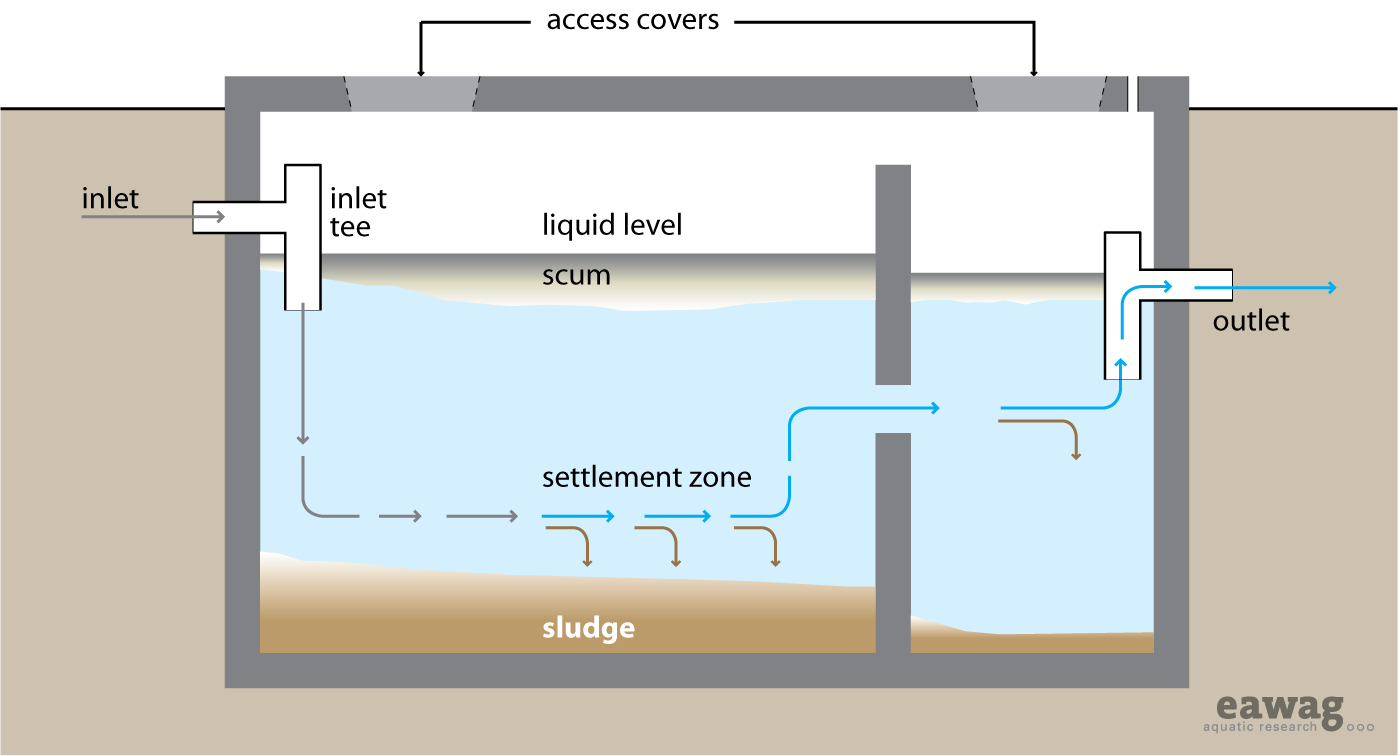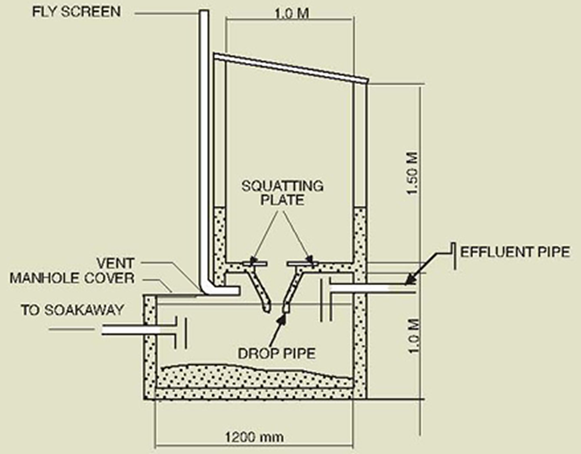Septic Tank
|
|||||||||||||||||||||||||||
A Septic Tank is a watertight chamber made of concrete, fibreglass, PVC or plastic, for the storage and treatment of blackwater and greywater. Settling and anaerobic processes reduce solids and organics, but the treatment is only moderate.
A Septic Tank should typically have at least two chambers. The first chamber should be at least 50% of the total length and when there are only two chambers, it should be 2/3 of the total length. Most of the solids settle out in the first chamber. The baffle, or the separation between the chambers, is to prevent scum and solids from escaping with the effluent. A T-shaped outlet pipe will further reduce the scum and solids that are discharged.
Liquid flows into the tank and heavy particles sink to the bottom, while scum (oil and fat) floats to the top. With time, the solids that settle to the bottom are degraded anaerobically. However, the rate of accumulation is faster than the rate of decomposition, and the accumulated sludge must be removed at some point. Generally, Septic Tanks should be emptied every 2 to 5 years, although they should be checked yearly to ensure proper functioning.
The design of a Septic Tank depends on the number of users, the amount of water used per capita, the average annual temperature, the pumping frequency and the characteristics of the wastewater. The retention time should be designed for 48 hours to achieve moderate treatment.
Contents
Aqua privy
A variation of the Septic Tank is called an aqua privy, which is a simple storage and settling tank located directly below the toilet, so that the excreta fall into the tank. A housing or shed is built over the tank. A vent pipe with a fly screen at the top end is attached to the housing.
To prevent odours from surfacing, a water seal must be maintained by adding sufficient water per toilet visit to the tank via the drop-pipe to replace any losses. However, this may not completely prevent smells and the tank must be frequently desludged. The effluent must be dispersed by using a Soak Pit or Leach Field or by transporting the effluent to another treatment technology via a Simplified Sewers or Solids-Free.
| Advantages | Disadvantages/limitations |
|---|---|
| - Can be built and repaired with locally available materials. - Long service life. - No real problems with flies or odours if used correctly. - Low capital costs, moderate operating costs depending on water and emptying. - Small land area required. - No electrical energy required. |
- Low reduction in pathogens, solids and organics. - Effluent and sludge require secondary treatment and/or appropriate discharge. - Requires constant source of water. |
Adequacy
A Septic Tank is appropriate where there is a way of dispersing or transporting the effluent. Because the Septic Tank must be desludged regularly, a vacuum truck should be able to access the location. Often Septic Tanks are installed in the home, under the kitchen or bathroom which makes emptying difficult. If Septic Tanks are used in densely populated areas, on-site infiltration should not be used otherwise the ground will become oversaturated and excreta may rise up to the surface posing a serious health risk. Instead, the Septic Tank should be connected to a sewer and the effluent should be transported to a subsequent treatment or disposal site. Larger, multi-chamber Septic Tanks can be designed for groups of houses and/or public buildings (i.e. schools). Generally, the removal of 50% of solids, 30 to 40 % of biochemical oxygen demand (BOD) and a 1-log removal of E.coli can be expected in a well designed Septic Tank although efficiencies vary greatly depending on operation and maintenance and climactic conditions.
Septic Tanks can be installed in every type of climate although the efficiency will be affected in colder climates. Even though the Septic Tank is watertight, it should not be constructed in areas with high groundwater tables or where there is frequent flooding. Aquaprivies can be built indoors and above ground and are appropriate for rocky or flood-prone areas where pits or other technologies would not be appropriate. However, because they require frequent emptying and constant maintenance, they are only recommended for very specific applications.
Health Aspects/Acceptance
Although the removal of pathogens is not high, the entire tank is below the surface so users do not come in contact with any of the wastewater. Users should be careful when opening the tank because noxious and flammable gases may be released. Septic Tanks should have a vent. A vacuum truck should be used to empty the sludge from the Septic Tank. Users should not attempt to empty the pit themselves except with a manual technology like the Gulper.
Upgrading
A Septic Tank that is connected to a Leach Field or a Soak Pit can later be connected to a Solids-free Sewer if/when one is installed.
Maintenance
Septic Tanks should be checked to ensure that they are watertight and the levels of the scum and sludge should be monitored to ensure that the tank is functioning well. Because of the delicate ecology, care should be taken not to discharge harsh chemicals into the Septic Tank. The sludge should be removed annually using a vacuum truck to ensure proper functioning of the Septic Tank.
Manuals, videos, and links
This document lists the specifications that need to be met for a succesful Aqua Privy.
References
Detailed Design Information:
- Mara, DD. (1996). Low-Cost Urban Sanitation. Wiley, Chichester, UK. Sizing, volume and emptying calculations and example design solutions, Chapter 6.
- Polprasert, C. and Rajput, VS. (1982). Environmental Sanitation Reviews: Septic Tank and Septic Systems. Environmental Sanitation Information Center, Bangkok, AIT, Thailand. pp 68–74. Comprehensive design manual.
- Sasse, L. (1998). DEWATS. Decentralised Wastewater Treatment in Developing Countries. BORDA, Bremen Overseas Research and Development Association, Bremen, Germany. Excel® Spreadsheet codes for sizing septic tanks.
General Information:
- Crites, R. and Tchobanoglous, G. (1998). Small and Decentralized Wastewater Management Systems. WCB and McGraw-Hill, New York, USA.
Acknowledgements
The material on this page was adapted from:
Elizabeth Tilley, Lukas Ulrich, Christoph Lüthi, Philippe Reymond and Christian Zurbrügg (2014). Compendium of Sanitation Systems and Technologies, published by Sandec, the Department of Water and Sanitation in Developing Countries of Eawag, the Swiss Federal Institute of Aquatic Science and Technology, Dübendorf, Switzerland.
The 2nd edition publication is available in English. French and Spanish are yet to come.



